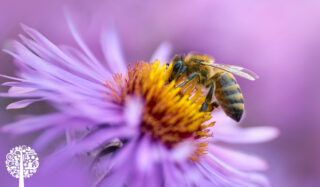
Purple Power: Gardens Going Mauve, Lavender, Violet, And Every Shade In Between
Last year, the Canadian Garden Council invited Canadians to plant red annuals and perennials to celebrate the landmark Year of the Garden. In 2023, together with Communities in Bloom (CiB), Canadians everywhere are invited to plant purple to celebrate garden life.

CiB’s mission parallels that of the Canadian Garden Council and focuses on enhancing the quality of life and the environment through plants.
By choosing purple for 2023, the hope is that gardeners will tap into the rejuvenating powers of gardening and the significance of purple’s connections to spirituality, imagination, and creativity.
Purple plants are available in shades of romantic mauve to dark magenta. Purple flowers are also renowned for attracting hummingbirds.
Purple Annuals Attractive To Hummingbirds
Petunia: Often used as a border plant, in hanging baskets, or potted up in planters, petunias are heat tolerant, love full sun, and will bloom from early summer to fall.
Zinnia: Available in shades of blush pink to purple, they can grow 2 meters high, love full sun, and bloom from early summer through to frost, attracting not just hummingbirds but bees and butterflies.
Heliotrope: Also known as the cherry pie plant for its sweet cherry scent, heliotropes grow in full sun to part shade. Growing half a meter tall, they move with the sun’s light throughout the day. Hummingbirds, butterflies, and insects flock to them.
Superbells, calibrachoa, or million bells: A plant with many names and available in various colors, including purple. They look like miniature petunias, enjoy full sun to part shade, and bloom from early summer to fall.

Cleome: An annual that grows into a bush and likes sun-to-part shade, fragrant flowers grow in shades of purple and pink, attracting hummingbirds, butterflies, moths, and bats.
Wishbone or clown flower: These white and purple tubular annuals grow in part shade and will bloom from late spring through summer.
Sweet Purple Alyssum: Low-growing with delicate sphere-shaped flower clusters in white, purple, or lavender, this plant needs six hours of full sun. Their sweet fragrance lures hummingbirds to the garden.
Purple lobelia: Perfect for trailing out of planters or hanging baskets! Lobelia will flower from summer to fall if trimmed back throughout the season. It enjoys sun to part shade, and hummingbirds flock to the flowers.
Purple Flowers Pollinators Adore
Phlox’ Purple Sprite’: Hardy to Zone 3, phlox blooms in full sun from mid to late spring.
Lavender: Drought tolerant and aromatic, Lavender loves full sun and is a must-have for any perennial border. It’s a favorite for hummingbirds and butterflies.
Lupins: A sun-loving, self-seeding early summer biennial (reappearing every two years), these plants come in shades of pink, white, and traditional purple.

Butterfly bush: The name speaks for itself! The plant’s stunning flower spikes are irresistible to hummingbirds and butterflies. Although available in white and pink, the most popular and familiar shade is purple. It thrives in full sun; the blossoms reach their apex mid-summer.
Purple coneflower: Also known as echinacea, this plant is native to North America. Its long-lasting blooms will carry through from early summer to mid-fall. Drought and heat tolerant, it grows best in drier climates.
Lilac: The late spring blooms of Lilac trees are a haven for pollinators. Available in white and pink, purple remains the most popular choice. This sun-loving shrub may only bloom briefly in late spring, providing sweet snacks for pollinators.
Bee Balm’ Balmy Purple’: Planting bee balm is a surefire way to attract hummingbirds, bees, and butterflies to the garden. Balmy purple is a light mauve variety that grows to a meter tall. Blooming in full sun to part shade, it keeps hummingbirds and other pollinators coming back for more!
Delphinium: Available in white, pink, blue, and of course, purple. A sun lover, if cut back after a first bloom in early summer, a second flush will keep the garden’s pollinators happy.

- Jennifer Cole
